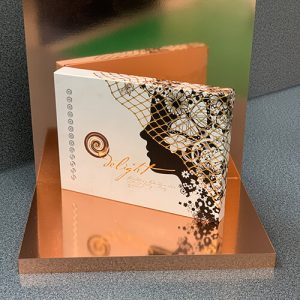Using metallics in fashion and design has been a trend for the past few years. It is not showing signs of slowing down either. Businesses can also use it to add shiny foil to different print media to make it stand out. A lot of individuals don’t have that much experience with these applications though. To help, we are going to offer our advice for designing print materials for foil stamping. We can then arrange foiling services for you.
Use smooth paper
Firstly, you will want to select a smooth paper. For the finest foiling results, you will have to stay away from papers with unevenness or texture. The less of the latter there is, the smoother your foil is going to lay down. Papers with soft touch effects or columns aren’t good here. Thick paper does a better job, so you would be wise to choose it.
Hairlines
You won’t want any hairlines either. Lines that are too fine could end up getting lost in the stamping procedure. One great rule of thumb is to ensure all your foil designs are at least 0.5 pt in thickness.
Compact spaces in text have a tendency to fill in too. For most fonts, the minimum recommended font size is 8 pt. Please speak to us if you wish to use our foiling services.
Watch the registration
 Stamped foil is able to shift slightly in any direction when the stamping operation takes place. So, exact registration (or alignment) of foils with ink is difficult to obtain. Utilising it as an overprint over solid patterns or colours will lower the chances of errors.
Stamped foil is able to shift slightly in any direction when the stamping operation takes place. So, exact registration (or alignment) of foils with ink is difficult to obtain. Utilising it as an overprint over solid patterns or colours will lower the chances of errors.
Your foil could be designed with reversed out art. If so, the stamper has to be meticulous. This is to make certain it doesn’t stray from the edges of the letters with each stamp. You could end up operating your press slower, which will only add cost and time.
Coverage influences price
The more square inches your foil design covers, the higher the cost you will need to pay. It is possible to cut foil down if your design is smaller. Although, you could have a border that is running all the way around the edges of your piece. If you do, it will be more expensive because it won’t be possible to cut it for savings. You can ask us about prices and how to save on costs when you choose our foiling services.
Adding texture
Next, we want to briefly talk about adding texture. You may be hand illustrating a foil design. If this is the case, remember that all textures are going to show up authentically in the final piece. However, you could convert your illustration to flat artwork if you are seeking a smoother finish in the final piece.
Press checking
If you wish to press check the foil application, there are multiple details you must watch out for. First, check alignment/registration as we already talked about. Check for impression as well. Lastly, ensure that you are applying the correct colour of foil.
Ask the provider
Finally, it is ideal to consult with your print provider. To secure the highest quality results, allow the printing team to review your artwork. Before everything is finalised, they will be able to point out any troubled areas and offer suggestions for improvement.
We’ll get you the results you want with our foiling services
At Foiling Services, we can work beyond the normal shades of silver and gold. In fact, we can offer foils in a huge range of colours and even different patterns. We use state of the art machinery for our projects and our technicians can meet the challenge of any available project.
Foiling services can deliver wonderful results. So, if you want to try it for yourself, feel free to call or email us. It could completely transform your print media and make a much better impression on your audience.
